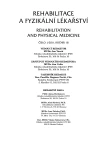-
Medical journals
- Career
Chrástková M., Bačáková R., Kračmar B., Hojka V.: Kinesiology Content of Selected Forms of Cross-country Skiing Used by a Wide Public
Authors: M. Chrástková; R. Bačáková; B. Kračmar; V. Hojka
Authors‘ workplace: Fakulta tělesné výchovy a sportu, Univerzita Karlova, Praha
Published in: Rehabil. fyz. Lék., 18, 2011, No. 1, pp. 32-38.
Category: Original Papers
Overview
Cross-country skiing is a recommended activity for optimal loading of human motor system, as the same time it is recommended as a part of post-rehabilitation motor regime. The gliding step in classical technique and V-2 skating are the most common used techniques in the recreational form. The aim of the study was to clear out how the motor stereotype of cross-country skiing corresponds with bipedal walking and which of the two basic techniques is more suitable (we use more natural) for the motor system. The used methods were the synchronized video record with the surface poly-electromyography in terrain (EMG). The data were interpreted on the basis of the comparative cross-correlation analysis of activation starts of the observed muscles. The female skier competing in the national team showed the similarity of phase moves of muscles stabilizing the pelvis and knee joint both during walking and cross-country skiing (both techniques). The difference between cross-country skiing and walking was found in phase muscles taking part on the propulsive strength for locomotion. It was not possible to compare the coordination relationship of the activity pairs: gliding step in classical technique – walking and skating – walking.
Key words:
cross-country skiing, walking, electromyography
Sources
1. DE LUCA, C. J.: The use of surface electromyography in biomechanics, [on-line], 1993, [cit. 1. 1. 2009]. Dostupné na www: http://www.delsys.com/.
2. GNAD, T., PSOTOVÁ, D.: Běh na lyžích. Karolinum, Praha, 2005, 151 s. ISBN 80-246-0995-9.
3. GREGORY, R. W., HUMPHREYS, S. E., STREET, G. M.: Kinematic analysisof skating technique of Olympic skiers in the womenęs 30-km race. J. Appl. Biomech., 10, s. 382-392.
4. CHRÁSTKOVÁ, M.: Speciální posilovací cvičení pro běžce na lyžích klasickou technikou. Diplomová práce, Praha, 2009.
5. ILAVSKÝ, J., SUK A.: Abeceda běhu na lyžích, metodický dopis. Jablonec nad Nisou, 2005, 209 s.
6. KRAČMAR, B.: Nové pohledy na pohybové aktivity člověka – I. Vývoj pohybu člověka v okolním prostředí. Těl. Vých. Sport. Mlád., roč. 73, 2007, č. 3, s. 2-7.
7. MASSAAD, F. M., LEJEUNE, T., DETREMBLEUR, CH.: The up and down bobbing of human walking: a compromise between muscle work and efficiency. J. Physiol., 582, 2007, č. 2, s. 789-799.
8. MERLETTI, R., PARKER, P.: Electromyography. Physiology, engineering, and noninvasive applications. John Wiley & Sons, Inc., Hoboken, New Persey, 2004.
9. VIITASALO, J. T., MÜLLER, E. et al.: Efects of 50km racing on ski skating kinematics in the Falun world championships in 1993 [on-line]. © In MÜLLER et al.: Science and skiing. Cambridge, Chapman &Hall, 1997, s. 88-96. ISBN 0-419-20850-X [cit. 5. 3. 2010]. Dostupné na: http://www.google.com/books?id=Qt7SlbwQVw0C&pg=PA421&dq=cross+country+skiing+klasic+technic&lr=&hl=cs&cd=6#v=onepage&q&f=false
10. RUSKO, H.: Cross country skiing [on-line]. © Blackwell Science Ltd. A Blackwell Publishing Company, 2003, s. 1. ISBN 0-632-05571-5.[cit. 5. 3. 2010]. Dostupné na: http://www.google.com/books?id=he7-eY86uIcC&printsec=frontcover&dq=cross+country+skiing+classic+technic&lr=&hl=cs&source=gbs_book_similarbooks#v=onepage&q&f=false
11. VANČATA, V.: Fylogeneze člověka a jeho předků. In: Švecová, M. a kol.: Nové směry v biologických oborech a jejich speciálních didaktikách. Praha, Karolinum, 2002, s. 47-84.
12. VOJTA, V., PETERS, A.: Vojtův princip. Praha, Grada, 1995, s. 25, 39, 95. ISBN 80-7169-044-X.
13. VYSTRČILOVÁ, M., KRAČMAR, B.: Nové pohledy na pohybové aktivity člověka – III. Chůze. TVSM, roč. 73, 2007, č. 5, s. 2-8.
14. VYSTRČILOVÁ, M., KRAČMAR, B., KOZELSKÝ, D., ŠKOPEK, M.: Dětské plazení jako základní forma lidské lokomoce prostřednictvím pletence ramenního. In: Sb.: Tělesná výchova sport mládeže v biologickém, psychologickém, sociálním a didaktickém kontextu. Ed.: Mužík, V., Dobrý, L., Süss, V. Brno, Masarykova univerzita, 2008, s. 65-79.
15. VYSTRČILOVÁ, M., KRAČMAR, B., NOVOTNÝ, P.: Ramenní pletenec v režimu kvadrupedální lokomoce. Rehabilitace a fyzikální lékařství, 13, č. 2, s. 92-98. ISSN 1211–2658.
16. WIGGER, J.: Optimale Kraftübertragung. Fit for Life (Läufer), 1998, č. 12, s. 34-37. SPORTIS P - 1/00.
Labels
Physiotherapist, university degree Rehabilitation Sports medicine
Article was published inRehabilitation & Physical Medicine

2011 Issue 1-
All articles in this issue
-
SVALOVÉ SYNERGIE HORNÍ KONČETINY:
POLYEMG STUDIE PRO KLINICKOU PRAXI - Horáček O., Schreier B., Lisý J., Kobesová A., Kolář P.: Application of Neurophysiological Procedures in Neurogenic Pareses of Abdominal Wall
- Benešová M., Holubářová J., Pánek D., Pavlů D.: The Use of Proprioceptive Neuromuscular Facilitation in Patients with Desault Fixation of Shoulder Joint
- Pánek D., Čemusová J., Pavlů D.: Diaphragm Paresis and Its Kinesiologic Consequence
- Pařík O., Hojka V., Kračmar B.: Surface Tension of Individual Muscles during Athletic Sprint and Skipping
- Chrástková M., Bačáková R., Kračmar B., Hojka V.: Kinesiology Content of Selected Forms of Cross-country Skiing Used by a Wide Public
- Šrámek P., Ticháčková J.: The Study Assessing Effect of DiaDENS-T Instrument in Adult Subjects with a Syndrome of Painful Knee Degenerative Etiology
-
SVALOVÉ SYNERGIE HORNÍ KONČETINY:
- Rehabilitation & Physical Medicine
- Journal archive
- Current issue
- Online only
- About the journal
Most read in this issue- Pánek D., Čemusová J., Pavlů D.: Diaphragm Paresis and Its Kinesiologic Consequence
- Horáček O., Schreier B., Lisý J., Kobesová A., Kolář P.: Application of Neurophysiological Procedures in Neurogenic Pareses of Abdominal Wall
- Benešová M., Holubářová J., Pánek D., Pavlů D.: The Use of Proprioceptive Neuromuscular Facilitation in Patients with Desault Fixation of Shoulder Joint
-
SVALOVÉ SYNERGIE HORNÍ KONČETINY:
POLYEMG STUDIE PRO KLINICKOU PRAXI
Login#ADS_BOTTOM_SCRIPTS#Forgotten passwordEnter the email address that you registered with. We will send you instructions on how to set a new password.
- Career

